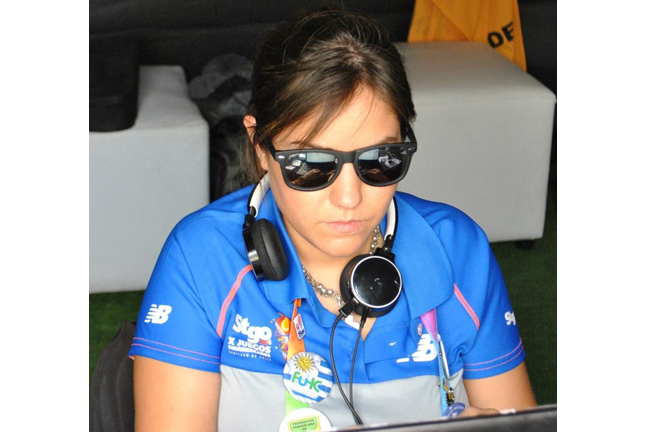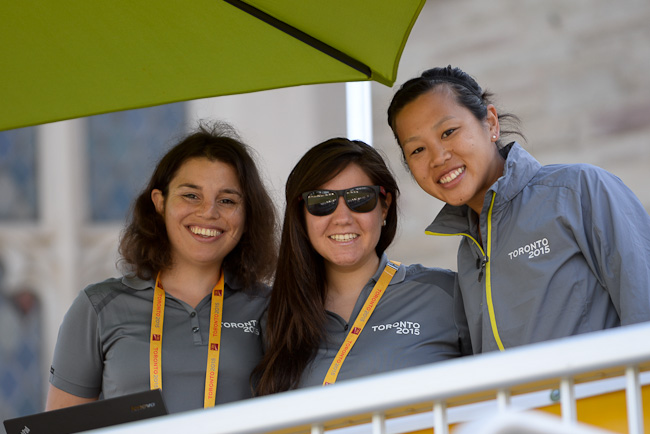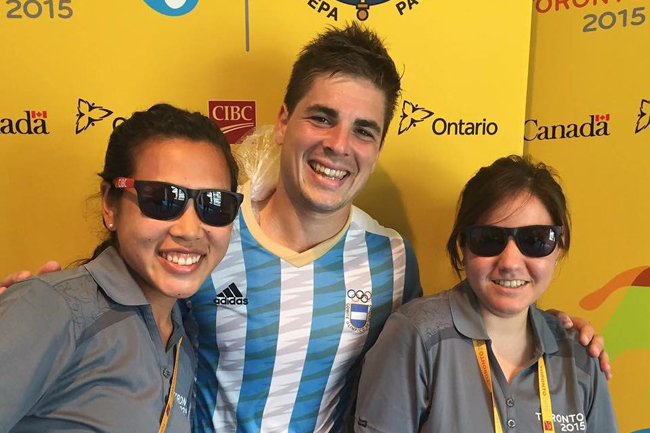
There are many behind-the-scenes roles at major events such as the Pan American Junior Championships. Some are sport-related jobs, such as team manager or medical support staff, other people work on the operational side, ensuring the pitch is watered, the ice is ready, and the ticket gate is manned. But a third group of workers are concerned with getting our sport out into the wider public eye. It is a crucial role because without stye support of spectators, hockey could not survive.
One such person is Candela Diaz Bustos, PAHF Communications Officer at both the women’s event in Tacarigua and the men’s event in Toronto. Here she crosses the line and turns from interviewer to interviewee.
Question: Can you describe your role at the Pan American Junior Hockey Championships?
I will be working at the Pan American Championships as Communications Officer for the Pan American Hockey Federation (PAHF). I will be sharing this wonderful experience with Damian Gordon from Trinidad & Tobago at the Women Junior Pan American Championship in Tacarigua and Kaelan Watson from Canada for the men’s event in Toronto. As a team, we will be responsible for the communications during the competitions for the PAHF. Our mentor, Yan Huckendubler, will join us as a photographer in Canada.
Q: What are your biggest challenges during the competition?
My job is to get the best from the athletes during the competitions, so the public get to know them. This is a challenge because they are junior players and most of them are playing for the first time in a big tournament like this. The prize is a place at the Junior World Cup and I want to capture their excitement and reflect it in the match reports, interviews and pictures that are posted on the PAHF web site and streamed through PAHF's different social media channels.
The other big challenge is the technical side of things. We want to spread the news as fast as possible: it is a priority for all the communication teams. As people responsible for the communications, we work to tight deadlines, sharing the best quality work as quickly as possible, and we always work as a team. Digital hockey consumers are very demanding. People watch us from all round the world so we need to work as fast as possible and keep them tuned in to our digital channels.
Q: Which part of the role do you enjoy the most?
During the last few years, after attending many international tournaments, I think I can now say that I have three top favourite things.
Travelling: It has opened my eyes to a new hockey world. At the same time it has taught me a lot of things about new cultures, hockey development and it has given me a lot of good friends from all around the world.
Interviewing: I think it is priceless when you get an answer that you have never expected or when players tell you that they really enjoyed the interview and they leave the mixed zone with a smile.
Analyzing the impact of our work on social media: This is the most surprising part so far. Pan American hockey is being followed by thousands of hockey fans around the world. Part of our work is getting the information out there in the most accessible form. I am beginning to understand why hockey is one of the top five sports around the world.
Q: How did you get into being a Communications Officer?
I have played hockey since 1993 and I love watching and playing. The first international hockey match I saw was Argentina vs Australia at the Jockey Club in Córdoba, Argentina, in 2000. I was 11 years old, in the middle of the journalists as they were trying to record their interviews and take pictures. I rushed home to ask my mother to lend me her camera. I started to write my own journal, where I posted pictures and reports.
It became real when I attended the Four Nations Tournament in 2004 and started to write for some national teams like Belgium and Australia for the World Cup Qualifier 2010. In January 2014 I received a phone call from PAHF where I was asked to work at the South American Games (ODESUR). It was then I realized this could become serious! I specialized in social media and digital communications and since then I have been officially traveling around the continent as a Communications Officer for PAHF.
Q: How do you prepare for player/coach interviews?
This is one of the most important parts of our job, so I do research and practice as much as possible. I am always trying to learn from the other communications officers.
When I do the research, I try to understand how hockey works in their countries, what's the particular tournament means to the players and coach, and of course, I watch the match intently so I can ask relevant questions. I try to keep abreast of the latest FIH Regulations and Rules Manual, and the PAHF Communications Guideline is always a useful document.
Q: How do the players react to your questions?
I always try to break the ice before starting an interview so the player feels more relaxed –remember they just have finished playing a hockey match. A funny question always helps. After that you can start the interview about the match. There are very professional players who give very professional answers but there are also players that open their hearts and talk with a lot of passion... smiles, sadness, disappointment, joy, tears.
Q: How does a typical tournament day look?
We think we are the very first people to wake up and get into the venue and the very last to go to bed! Seriously, we arrive at the venue two hours before the match, and we leave when the work is done, this can take many hours after play finishes. We depend a lot on the speed of the internet at the venue to get our reports sent. It is also a question of how fast we get the players to the mixed zone to do the interviews. Then, we edit the interviews, upload them to our digital channels, write reports in Spanish and English, upload pictures, and finish with a daily feedback meeting.
Q: What has been your best tournament so far, and why?
The Pan American Games in Toronto without a doubt. We had an experienced communications team with Ali Lee, Rebecca Kanter and Yan Huckendubler. It was almost perfect, the accommodation, the venue, the high speed internet, the good environment.
I also had the chance to cover the finals of the Champions Trophy in Mendoza in December 2014 and observe a full stadium for the last match of Luciana Aymar. That was big! My answer might change after the Olympic Games in Rio next August…
Q: Have you ever asked a really dumb question and been embarrassed?
Yes, of course! I was in Veracruz for the CAC Games and started to interview Leigh Sandison from Guyana and started to ask questions about the match... but from the day before! Thankfully, she tactfully pointed out my mistake and we started the interview again... My sticky note after that: “Always remember to write the title to your questions in your notebook.”
Q: What would your advice be to a person wanting to do a similar role?
If you have the chance to do it, do it with passion! Study another language (English, Portuguese, Spanish, etc.), read and keep yourself updated on the trends in the sport. Take courses in social media, communications and protocol. Learn to listen, this is very important.
Q: Where do you feel your role sits - are you a media person, are you an official or are you a bit of both?
I think our role as Communications Officer sits a bit in both of them. We (and I include all my media team mates) are part of a bigger team, that includes judges, umpires, umpire managers, doctors, managers, directors, representatives, competition coordinators. Our work reflects that balance. And I love being part of the big team.




